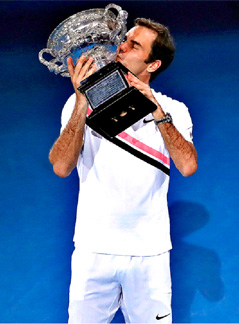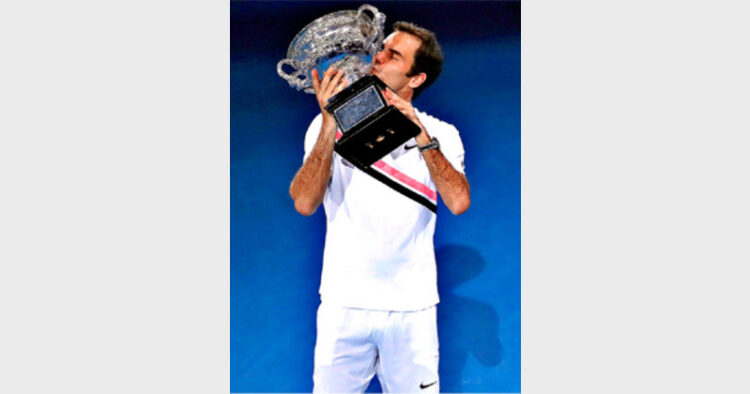
- At 36 years, Roger Federer becomes the oldest man to win a Grand Slam title since Ken Rosewall in 1972.
- Only man to win five consecutive titles at two different grand slams – Wimbledon and U.S. Open.
- First man to win Wimbledon-US Open double four years in a row.
- Only man in the professional era to win three consecutive majors twice in his career when he captured the 2007 Australian Open title.
- Matched Bjorn Borg’s record of five consecutive Wimbledon titles in 2007.
- His 2009 French Open crown made him the sixth man – after Fred Perry, Don Budge, Rod Laver, Roy Emerson and Andre Agassi – to have won all four grand slam titles during his career. Nadal later became the seventh to achieve the feat and Novak Djokovic joined the list in 2016.
- Breaks American Pete Sampras’s record of 14 grand slam titles with his 15th win in the 2009 Wimbledon final
- Becomes the 23rd man to top the ATP rankings in 2004, and keeps the ranking for a record 237 consecutive weeks. By winning his seventh Wimbledon title, he also matches Sampras’s record of spending 286 weeks as world number one.
- Holds a record run of 24 consecutive final victories
- In 2006, he reached all four grand slam finals, winning in Australia, Wimbledon and the US among a haul of 12 titles
- Has a professional era record of 65 consecutive wins on grass, which was ended by Nadal in the 2008 Wimbledon final.
- Comes back from six-month injury lay-off to win the 2017 Australian Open and at 35, becomes the oldest player to win a grand slam title
- Won an unprecedented eighth singles title at Wimbledon in 2017
There were tears in the eyes of Roger Federer, while he was accepting his 20th Grand Slam title. Rod Laver took a chance to snap a picture for posterity. Federer has won more major titles than any one else, including a record equaling six on the court that bears Rod Laver’s name at the Melbourne Park. This one, following a tension filled, momentum swinging 6-2, 6-7,6-3,3-6,6-1 win over Marin Cilic in Australian Open final, was a keeper. Laver has been involved in the on-court presentations in the past, witnessing Federer’s tears at close range. This time, Laver- the only man to achieve the calendar grand slam twice- held up his phone to get the shot from the stands. Later, in a television interview he said, “I didn’t see that through my thick tears he was taking a crying picture of mine. I couldn’t lift my head, I was so embarrassed”. As to whether such phenomenal career resurgence is indeed an embarrassment or embarrassment of riches has become a global public debate. For Roger Federer is not a mere player. He is not a mere legend either. He has become a phenomenon. Federer arrived in Melbourne at the start of 2017 after an extended injury lay off and on a Grand Slam title drought that dated back to 2012 at Wimbledon. Having successfully defended his Australian Open title, Federer has now won three of the past five majors in stunning career resurgence. At the age of 36 years, 173 days, Federer became the second-oldest man to win a Grand Slam title in the open era after Ken Rosewall who won the 1972 Australian Open at 37.
This and many other trivia’s have now become too miniscule to describe the global sporting phenomenon called Roger Federer. David Foster Wallace was among the first to diagnose the phenomenon, in his essay, “Federer as Religious Experience”. According to the late American novelist, the Swiss star’s defining feature was that he regularly hit shots that violated the law of physics, that was “impossible”. He famously described these as “Federer Moments”. Some of his fans in United Kingdom regard him being a vessel for some higher power, something lying beyond ordinary comprehension. It follows that watching him is almost a form of religious observance. Mute reverse is the only correct response. While watching the match of Federer a teenage Non-resident Indian boy in the east of London puts a placard in his dining room- ‘shh, genius at work”. What also follows is that being an ardent Federer fan one feels, at times, like belonging to some vast cult, with members scattered all over the place. Wherever one goes, one encounters people who have been similarly touched, who like the Non-resident Indian boy in London, have seen the one true way.
As Federer’s good friend and the editor of US Vogue says, “These fans, I have discovered, crop up anywhere. Sure, you will find them in the expected places: at tennis clubs, in the stands at his matches. But I have encountered them in less obvious locations. At smart dinner parties, I have met high powered bankers who, when the minute Federer is mentioned, drop their guard and come all over weepy. I once took a ride from a taxi driver who confessed that he felt more strongly towards Federer than he did towards his own wife. At the public courts near my residence, I met a Polish man so obsessed with the Swiss that he taught himself to play in the exact same style, spending countless hours in front of slow motion shots of his idol, racket in hand. He has off course named his son Roger”. If some of his shots defies the rules of physics, his fan following defy the rule of marketing. They could not be broken into the target audience. Unlike the Nadal fans, which tend to be in their teens or early twenties, Federer fans could be of any age. They are ten year olds and they are octogenarians. Now, there is an ever increasing fan following in the middle age too, as this phenomenon through his resurgence, so late in his life has given them hope that they could too live and fight like a teenager. They can be from any country and straddle every social class. To understand this, one has to go to the South Africa from where his mother belongs, where he used to visit in his vacations as a child and now which has become the epicenter of his foundation. The people from as diverse a place as Durban to the Cape Town share an exemplary connect with this tennis legend. There is really no one type of his fan following. Well, from where did the phenomenon called Roger Federer originate?
Roger’s dad, Robert met Lynette during a holiday to South Africa when he was in 20s. They married in 1973 and moved to Basel, Switzerland—where they had two children, Roger and his elder sister Diana. According to Robert, his son inherited his athletics gifts from his mother. Lynette grew up in Johannesburg and was a top athlete at school in several sports, including hockey which she had to quit because of leg injuries. In his article on Heavy.com Lynette says her advice to parents of gifted children is, “The children have to put their hearts and souls into it. They cannot be forced to do it, not by the mother, the father, the school, or the coach’. More importantly, Lynette also revealed in interviews that her earliest memories of Roger as a toddler are of him with a racquet and ball and hitting against a wall or garage for hours. She says he was not always a gentleman we see on court. As a child he was hot tempered and would even throw his racket on the ground during matches. According to Lynette, she and his father were never angry with him for losing. They used to be angry ever for his bad behavior. She said she would point out afterwards that he had just helped his opponents win by letting his behavior send an invitation to be beaten. No wonder, Federer, the greatest tennis player, at a personal level, is known for being exceptionally nice. He’s polite, has impeccable manners and exhibits remarkable patience in dispensing his many obligations. It’s not that everyone likes him nevertheless. Many regard his affability as masking a core of extreme arrogance. Some think him ungracious. When describing his own game, he has a fondness for words like “amazing” and “incredible”, which strikes many as embarrassingly immodest. But these blips apart- his rooted upbringing has ensured that he is the biggest ambassador of sports. His tweeners (when he hits the ball between his legs), the ridiculous angled passing shots and the stupefying drop shots- are important part of the picture. But there’s a deeper truth to Federer’s ascendency. Tennis over the years has seen huge technological progress. This has resulted in the craft, finesse and elegance being lost and power, speed and excitement being gained. Players like Nadal and Djokovic are futuristic. Federer is often described as throwback. His game is both contemporary and old fashioned, modern and classic. And this is the Unique Selling Point of the phenomenon called Federer.
Sachin Tendulkar was India’s first modern global sporting phenomena. He had a universal appeal and strong family and cultural rules. But then, cricket is the global game with a limited appeal confined to handful of nations. Our dream is to see an Indian scaling the Himalayas of the universal sporting landscape in the sports with a huge global appeal. And, the country with a huge demographic dividend will be standing behind Sachin Tendulkar who will be capturing the photographs of that teary eyed Indian global sporting phenomenon. While the global sporting Indian phenomena will be marvelling on the field, a teenage Indian diaspora watching the match will be displaying a placard-” shaant, a genius is at work”. This may seem impossible now, but we have the talent and cultural roots of making this dream coming true.
-Abhishek Dubey
(The writer is a senior sports journalist)













Comments